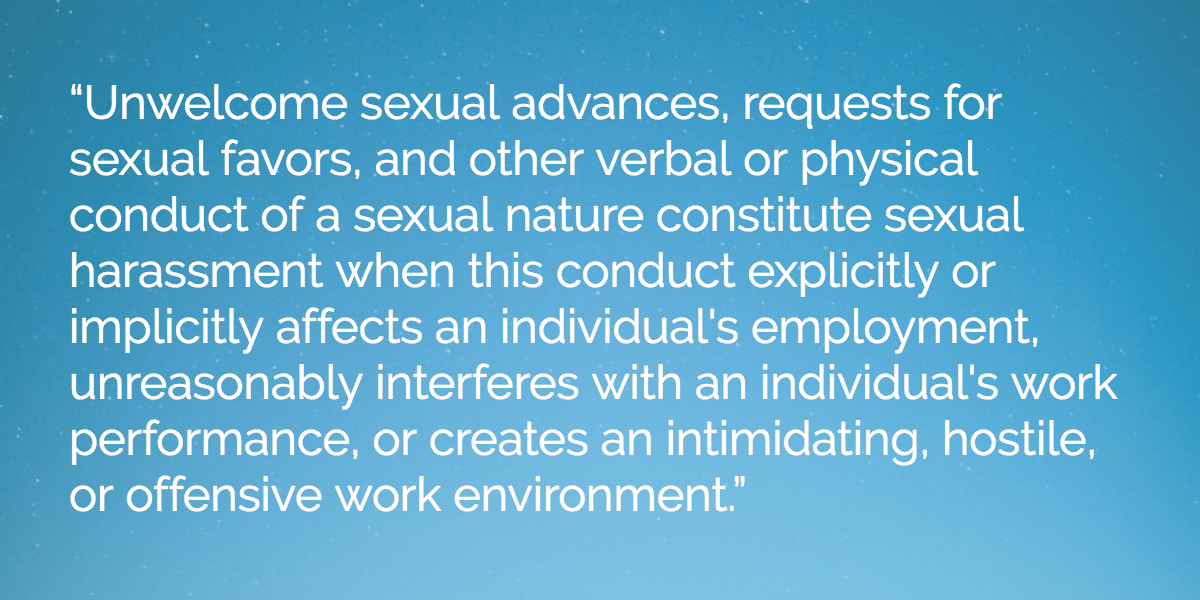
The national conversation about sexual misconduct seems to have reached a flashpoint in the past several months, with high profile men and women in virtually all industries sharing their painful personal stories. Anyone who has observed the virality of the #metoo movement and the Time’s Up campaign can see this is an issue that hits close to home for many people.
There’s an unfortunate common thread in many of these stories: the workplace. Since nobody wants their company’s name to be the next headline, this cultural moment should serve as a sign that corporate leadership and HR managers need to re-examine their office culture and sexual harassment policies.
The role of HR
In most companies, human resources is tasked with maintaining compliance with state and federal law, and following documented processes to address employee complaints. Whether or not it’s expressly stated, the overall goal of these responsibilities is to protect the company from legal trouble.
While this is an important piece of the puzzle, experienced HR managers know that it doesn’t show the whole picture. Another crucial aspect of the job is cultivating and maintaining a positive, productive company culture.
That’s why looking at sexual harassment as only a legal consideration, and not a cultural one, is shortsighted. Even if employees who experience harassment never choose to take legal action against the company, the effects of mishandled accusations are wide-ranging and hard to overcome.
When employers don’t take each reported incident of sexual harassment seriously, it sends a message to employees that their safety is not a priority. This can result in a disengaged staff, reduced productivity, and other negative cultural impacts that can easily be felt for years in the wake of an incident.
This is pretty serious stuff, right?
Unfortunately, when it comes to preventing and addressing incidents of sexual harassment, there is often little in an HR manager’s toolkit. So what can you do to prevent your company from becoming an unsafe, unwelcoming environment? Here are some things to consider:
Be clear about what constitutes sexual harassment
According to the Equal Employment Opportunity Commission:

There’s probably nothing in that description you haven’t seen before. But they also note that:
“Harassment does not have to be of a sexual nature, however, and can include offensive remarks about a person’s sex. For example, it is illegal to harass a woman by making offensive comments about women in general.”
While you should certainly share these legal definitions with employees, you may want to provide further clarity. Consider sharing additional examples of behaviors that would qualify as harassment, such as:
- Unwanted jokes or comments, whether or not they’re directed at a coworker
- Offensive or suggestive language on clothing
- Unwanted physical contact of any kind (including hugs, backrubs, and other touches that some employees may view as “innocent”)
- Watching or listening to sexually suggestive material (including online videos, music, pornography, etc.) in the workplace
- Sharing emails that include pictures or descriptions that are sexual in nature
- Unwanted flirting or repeated requests for dates that are turned down
These guidelines can serve as a teaching opportunity for employees, as well as a useful test to help employers decide when a line has been crossed. HR managers should ensure that every single employee—from the executive board to summer interns—is familiar with these standards from their first day on the job. It’s also wise to have these standards displayed in the workplace and included in the employee handbook.
Make it a continuous conversation
Some states require employers to provide sexual harassment training at regular intervals, but otherwise, the conversation may be limited to an employee’s first few days at the company. While it is wise to be very clear on the matter from day one, the conversation should not end there.
If you haven’t had a recent company-wide conversation about what behaviors constitute sexual harassment, and what employees should do if they experience or witness it, it’s not too late to start now. Whether you talk at your next company-wide gathering, or in individual team meetings, seize the cultural moment to open up an ongoing conversation throughout the company.
Remind employees that sexual harassment is in the eye of the beholder. It may be useful to discuss examples of what might be considered “gray areas,” including jokes or seemingly-benign touches such as hugs or back rubs. When they’re unwanted, these behaviors constitute harassment.
A good rule of thumb to share with your staff: if you’re unsure whether something may constitute inappropriate language or behavior, it’s best to avoid it.
Take every accusation and incident seriously
In an ideal world, your serious conversations with employees would serve as a clear enough warning to deter all inappropriate behavior. In the real world, however, you are likely to have to address incidents of sexual harassment from time to time.
Be sure employees and supervisors all know what to do if they experience, witness, or hear about inappropriate sexual behavior in the workplace. As soon as an employee reports an incident to a coworker or manager, HR managers should be brought into the conversation to begin investigating and reporting the claim.
If you work for a large company, you may have internal guidelines that dictate every step you need to take when presented with a sexual harassment complaint. If not, here is an EEOC-approved list of questions that can help you get started.
While the individual steps of the process may vary from company to company, there are some common considerations to keep in mind:
Maintain complete confidentiality in the process.
Fear of retaliation is a common reason for employees to avoid reporting inappropriate incidents. Ensure employees that their names and identifying information will be withheld from any conversation involved in the investigation.
Get started immediately.
This is both a personal and practical concern. Employees need to know their concerns are taken seriously, and any witnesses to the behavior need to be interviewed while their memory of the incident is clear.
Keep thorough documentation.
When you’ve finished investigating a claim, be sure to write a comprehensive report, including notes from any interviews you conduct. This documentation is important for protecting the company legally, whether you ultimately dismiss the claim or dismiss the accused employee.
Encourage diversity in leadership
As with all aspects of company culture, there may be entrenched behaviors and attitudes that make some workplaces more likely to have incidents of sexual harassment or assault. Every person has blind spots about how some of their behaviors impact others. That’s why it’s so important to include diverse perspectives at every level in the company hierarchy.
For instance, an all-male management team may be unaware when they’ve created an “old boys’ club” environment. When some employees share recreational interests with the boss, they may get more face time than their coworkers, leading to more favorable assignments or faster promotion through the ranks. The result is often a workplace where the people in leadership positions all have the same backgrounds. In these environments, it’s easy for inappropriate jokes about gender and sexually suggestive comments to become accepted as normal.
As many female business leaders can attest, this exact scenario has played out in countless workplaces for decades, and it has prevented competent women from getting the recognition they deserve. Taking stock of and correcting these imbalances in any company will take time and concerted effort, but making a point to include diverse perspectives in conversations about workplace behavior is an excellent place to start.
Start today
While these conversations can be awkward to start, and need to be handled with a lot of sensitivity, it would be unwise to avoid taking action until you feel ready. In such a tense cultural moment, your employees need reassurance that their emotional and physical safety are a priority to company leaders. By taking advantage of the increased awareness around this issue, you can clarify and strengthen your company’s stance on sexual misconduct, creating a safer workplace culture for all employees.
